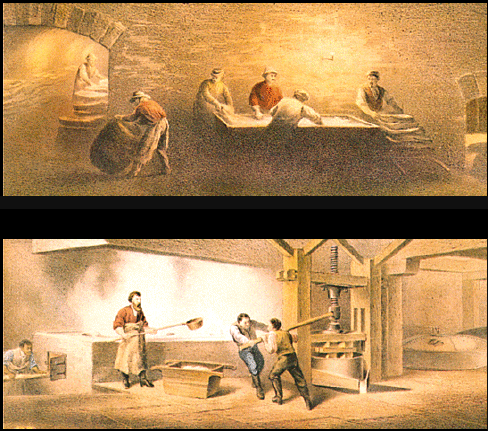
OVERALL DEFINITION: Development, spread, penetration, integration and rationalization of national and international markets, meaning systems in which people and companies bought and sold goods and services, for money. A process that had been going on for years, but achieved a revolutionary "advance" in 19th-century America by sweeping away many geographical, cultural and ideological barriers. Went hand in hand with urbanization and industrialization.
I. What Came Before: The "Household Economy" of Early America
A. Characteristics
1. Economic production takes place within (& is organized by) the family. All members of family were workers & vice versa.
2. Goals & horizons limited but relatively certain: men sought a "competence" that would allow independent support of family w/ enough extra to give children an opportunity for the same type & style of life.
3. Much production & exchange took place outside of "free" markets and w/o benefit of money.
Examples: barter, exchanges of labor to settle debts, assizes of bread.
4. Role of women: had direct roles in economic production & other activities without necessarily being accorded
5. Regulation of life by tasks designed to fulfill needs, tasks which varied from time to time (especially by season), and place to place.
Production not unlimited.
6. Most people directly involved in producing some tangible, useful thing. Relatively few people work for wages.B. Urban variant: Artisans and the craft system.
1. Definition of an artisan: skilled laborers, such as cordwainers, printers, wheelwrights, coopers, chandlers, bakers, tailors, hatters, blacksmiths, coachmakers, tinsmiths, silversmiths.
2. Predictable life-cycle of an artisan: apprentice (child-teen), journeymen (young, single adult), master (married, owner of shop).
3. Learned all aspects of trade in course of education, eventually including "white-collar" aspects;
4. Pre-industrial work discipline: worked by the task, filling customer orders, not constantly to produce for a potentially unlimited market; performed different tasks depending on time of day, week, month, year.
II. General Economic Changes
A. Increased opportunity & convenience, lower living costs, access for more people to a larger number of goods and services.
B. The Communications & Transportation Revolutions: Greater geographic mobility and wider access to news and information.
C. Growth and concentration: increase in the size, profitability, and geographic scale of business operations, decimation of smaller ones. Also applies to land-holding in long-established areas.
D. Specialization: regional (manufacturing in cities, staple agriculture only in most productive areas), personal (concentrating on one crop or business, or one aspect of a craft).
E. Embodiment & cause of many of these trends: the rise of the factory.
1. Definition: concentrating as many aspects of production in one place as possible and dividing the work into specialized tasks that could be performed more rapidly by less skilled (thus cheaper) workers.
Cincinnati Meat-packing Plant

2. Organizational innovations as important as technological ones.
F. Rise of a money-based economy: "use-values" to "exchange values."
III. Changes in Work, Values, and Social Structure
A. Formation of modern class system: Decline of social mobility through the life cycle, rise of permanent upper, middle and lower classes. Definition of middle and lower classes: both employees but lower class made up of permanent relatively unskilled workers and agricultural laborers who didn't own their own land.
B. Rise of wage labor as most common form of work. Implications and corollary changes:
1. More people become consumers rather than producers.
2. Change in life-goals, values, standards of value: from competency or "reproduction" of lifestyle to unlimited improvement and accumulation of wealth.
3. Communal or "patriarchal" orientation to individualism.C. Change in economic function of family: home no longer the scene of production, but a haven from it, women lose economic role, women and children become sentimentalized, family seen as place of love, morality, nurture rather production. Families get smaller and more "private."